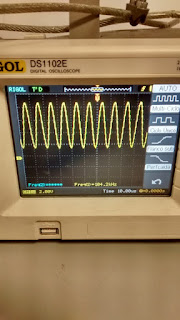ELECTROSURGICAL
BackGrounds:
An electrosurgical unit (ESU) delivers high-frequency electrical current through an active electrode to produce cutting and coagulation effects on tissues. The frequency of electrosurgery for cutting is between 100 kHz and 5 MHz, which is within the radio frequency (RF) band [1].
At the beginning of the procedure, the passive electrode (or return
electrode) is attached to the patient’s body. The surgeon then applies the
active electrode to the surgical site to achieve the surgical effect. The active
electrode is usually a very small tip electrode, while the return electrode has
a large contact surface area with the patient [1].
The surgical effect is due
to heat created by the RF current at the tissue–active electrode interface. The
degree of heating in the tissue depends on the resistivity of the tissue as well
as on the RF current density.
Three different tissue effects can be created by an electrosurgical current
at the active electrode site: desiccation, cut, and fulguration.
MODES OF ELECTROSURGERY
monopolar:
The current flows between two electrodes, completely surface different The active electrode has a very small surface to favor the increase of the applied current density, in this way the desired cutting or coagulation effect is obtained. The passive electrode has a very wide surface, ensuring that the current density through it is very low.
 |
| figure 1 passive electrode position |
bipolar:
the current flows between two electrodes of the same surface, allowing to control in this way the path that runs through the applied current and thus delimiting the tissues that will suffer the desired effect. This mode is usually used basically to produce a coagulation effect.
There are different mixtures between cutting and coagulation producing the waveforms shown in figure 2
 |
| figure 2 blend waveform |
Design:
electrical diagram:
 |
figure 3 electrical diagram
To perform the electrobisturi it was necessary to use a signal generator to modify the cut signal in this case an XR2206 was used, on the other hand to control the coagulation signal, a timer 555 was used together with the XR2206 to control this The PWM of the signal, on the other hand to join the stage of high power with the low one was used a relay a tip 122 which is designed for amplifiers of general use and low speed switching.
Mathematical Desing
In order to find the required frequencies, the first thing is to determine the frequency of the generator. Formula 1 was used, where the value of the capacitor was always fixed and the value of the resistor was in our case, a potentiometer was used, the capacitor value was 0.01uF and the value of the ponciometer was 100K
 (1)
To calculate the pulse for coagulation, equation 2 was used, which allows to calculate the pulse frequency of the timer.
 (2)
Results:
As a result we obtained the graphs of figure 3 and 4 where we can see that when in cut mode the wave is continuous and the sine wave determines the frequency at which the cut will be made since we use the frequency that comes from the network would not be enough to cut, on the other hand in the other figure you can see that the sine wave is not continuous because to do the coagulation it is necessary to have these times in this way only heats the scalpel allowing the wound to be cauterized more not that it reaches to make the cut. in the coagulation graph there is the same frequency as the cut, varying the time that will be that frequency.
figure 3 graphic coagulation
figure 4 graphic cut
CONCLUSIONS
It was possible to carry out an electrobisturi model capable of helping us to understand the principle of operation of the same, on the other hand it was possible to add new concepts to our lexicon.
It is very important to be careful when determining the frequencies and voltages used because they can cause harm to the patient and the manipulator.
BIBLYOGRAPHY
Juntadeandalucia.es. (2012). Electrobisturíes. [online] Available at: http://www.juntadeandalucia.es/servicioandaluzdesalud/hinmaculada/intranet/view_pdf.asp?id=116022 [Accessed 3 Mar. 2019].
Asit.org. (2019). principles electrosurgery. [online] Available at: https://www.asit.org/assets/documents/Prinicpals_in_electrosurgery.pdf [Accessed 4 Mar. 2019].
|








No hay comentarios.:
Publicar un comentario